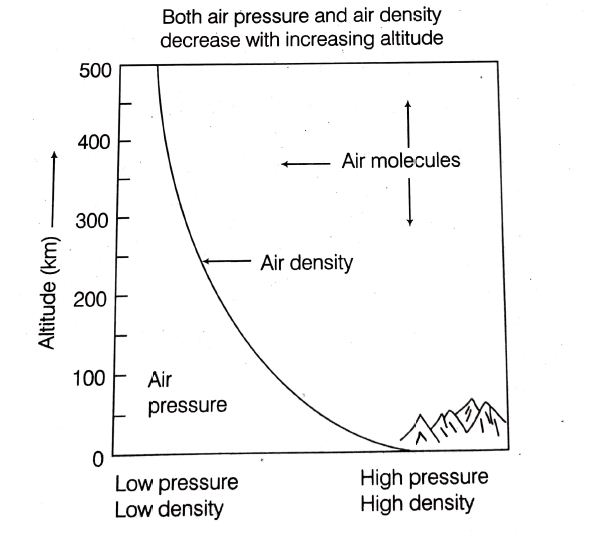How does Atmospheric Pressure vary with Altitude? show with a graph
Last updated on June 24th, 2023 at 02:05 pm
As we go to higher altitudes such as top mountains the atmospheric pressure is found to decrease. The following are the reasons behind atmospheric pressure fall at higher altitudes:
(i) Density of air decreases at higher altitudes.
(ii) Height of the air column above us also decreases.
A variation between the altitude and pressure/density is shown in the graph given below.

The graph above shows how both air pressure and air density decrease with increasing altitude.
Variation of Atmospheric Pressure with Height – some facts
- The atmosphere stretches about 150 km above Earth’s surface. However, about 80% of the atmosphere’s gases are found within 10 km of the Earth’s surface.
- At the top of the atmosphere, pressure is almost nonexistent. The pressure is close to 0 Pa because there are fewer gas particles and they rarely collide.
- The small number of gas particles is one of the reasons it is harder to breathe at high altitudes. Mount Everest in south-central Asia is the highest point on Earth. At the top of Mount Everest, atmospheric pressure is about 33,000 Pa, or 33 kilopascals (33 kPa).
- People who climb Mount Everest bring oxygen tanks to help them breathe at that altitude. At sea level, atmospheric pressure is about 101 kPa.
Atmospheric pressure variation as we travel through the atmosphere
Take a look at Figure 2. Notice how atmospheric pressure changes as you travel through the atmosphere.

As you travel farther down into Earth’s atmosphere towards the surface of the Earth, pressure increases. In other words, the pressure increases as the atmosphere gets “deeper.”
An important point to remember about fluids is that pressure varies depending on depth.
At lower levels of the atmosphere, more fluid from above is being pulled by Earth’s gravitational force. So, there is more pressure at lower levels of the atmosphere.
Pressure Changes and Our Body | Popping of ears
What happens to our body when the atmospheric pressure changes?
If we travel to higher or lower points in the atmosphere, the fluids in our body have to adjust to maintain equal pressure.
We experience this adjustment if our ears pop when we are in a plane taking off or are in a car traveling down a steep mountain road.
The “pop” happens because of pressure changes in air chambers behind our eardrums.
